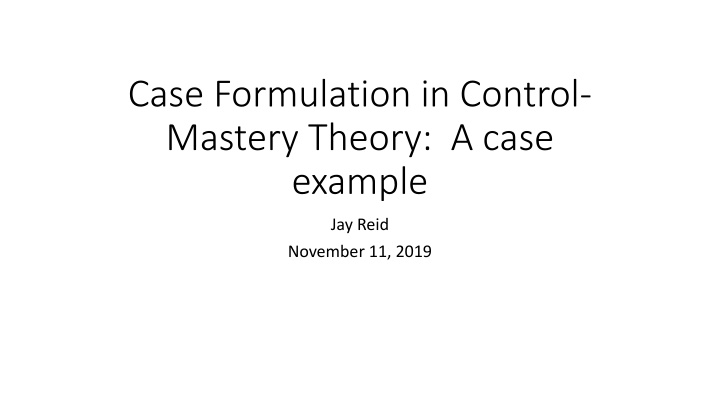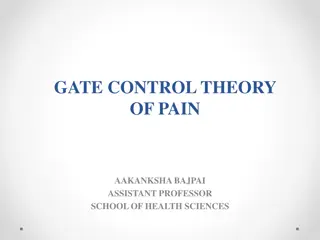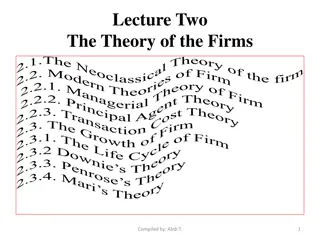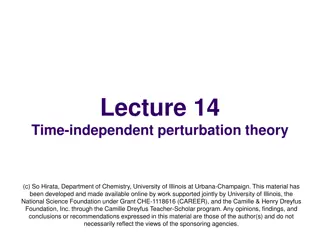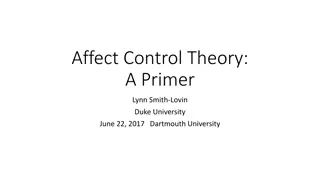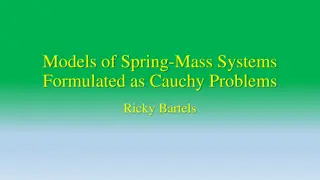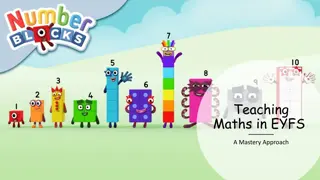Case Formulation in Control-Mastery Theory: A Case Example
A Control-Mastery Theory (CMT) approach to adults reflecting childhood experiences of being neglected and impinged upon by parents. This theory addresses pathogenic beliefs and adaptations developed in response to such upbringing, tackling issues like depression, anxiety, and dissatisfaction. The case explores themes of self-doubt, fear of close relationships, and guilt, shedding light on how neglected individuals perceive themselves and their relationships.
Download Presentation

Please find below an Image/Link to download the presentation.
The content on the website is provided AS IS for your information and personal use only. It may not be sold, licensed, or shared on other websites without obtaining consent from the author.If you encounter any issues during the download, it is possible that the publisher has removed the file from their server.
You are allowed to download the files provided on this website for personal or commercial use, subject to the condition that they are used lawfully. All files are the property of their respective owners.
The content on the website is provided AS IS for your information and personal use only. It may not be sold, licensed, or shared on other websites without obtaining consent from the author.
E N D
Presentation Transcript
Case Formulation in Control- Mastery Theory: A case example Jay Reid November 11, 2019
A CMT approach to adults who were Ignored and Impinged-upon as children The order of preference for a child s experience of his relationship with his parents is 1) a good relationship, 2) a bad relationship, and 3) no relationship. #2 will be insisted upon over #3 Some parents are unable or unwilling to attune to a child s inner world. They see the child as an extension of themselves. Adult children of such neglectful and impingeing parents will often show up in therapy. Presenting complaints can include: depression, anxiety (particularly in situations where they stand out), a general sense of dissatisfaction with life, and underdeveloped areas of their lives (e.g. successful at work but inhibited from seeking a life partner) CMT addresses the underlying pathogenic beliefs/adaptations that children had to make to survive such upbringings The trauma of chronic neglect can feel very undifferentiated. It contributes to a PB along the lines of I don t deserve to live happily & healthily .
The Pathogenic Beliefs Scale PB s tend to cluster around these 6 themes: Self-Doubt; Doubt of Others; Expression of Anger; Fear of Close Relationships; Guilt of Success; Responsibility Guilt I am afraid of being disappointed if I live in a close relationship I am afraid of being rejected if I ask too much from others. I am afraid of getting hurt if I live in a close relationship. I am afraid of losing my autonomy if I live in a close relationship I come into conflict if I express anger. I doubt that I am a person worth being loved. I doubt that I am an attractive person. I doubt that I can rely on my abilities. I doubt that I can rely on others. I doubt that others mean well. I fear being a burden if I ask people for help. I fear hurting others feelings if I express anger. I fear that others cannot help me if I need them. I fear that others perform better than I do. I fear to be rejected if I make mistakes. I fear to be wrong when showing anger. If I am away from home, I worry about my family. If I follow my own interests, I have a bad conscience. If I succeed, at work or in private life, I usually play down my achievements. If I succeed, I cannot really feel happy. If I succeed, I sometimes believe that I do not deserve it. If others feel bad, I am going to help, even if it means personal disadvantages. If others feel bad, I am not able to feel really happy. Reference Sammet, I., Leichsenring, F., Schauenburg, H., Andreas, S. (2007). Self-ratings of pathogenic beliefs: A study based on the psychodynamic control-mastery theory. Psychotherapy Research 17(4):494-503
Themes of Pathogenic Beliefs of the neglected & impinged-upon client Undeserving Of being provided for Of being listened to Of being the source of others happiness Of being safely autonomous Overly Responsible in Relationships Feel responsible for others emotional welfare Believe others needs are more important than their own Expect retaliation for not taking too much responsibility
Cultivating a Pro-Plan attitude Be careful where you place your therapeutic allegiance Clients will often express Tx goals that are anti-plan Pay attention to your own sense of this client in addition to their self-report of what their problem is Clients may have had the experience that knowing their capacities, talents, and/or admirable qualities posed a danger in a needed relationship Therapists have the opportunity to know what s not been safe for the client to know about themselves namely how good they actually are Grounding your attitude towards the client in this set of epistemological assumptions lets you challenge and interact freely with the client because you know it is in their best interest
Case Example Jillian* is a 39yo woman who came to therapy five years ago complaining of crippling Depression and Anxiety. Initial Dx of Bipolar II. Transferred to me in 2015 Lives alone. Works hard and very competently at her job Her personal and social life consist of working during the week with no time do anything social after work, meeting up with longtime friends on the weekends all of whom are generally married with kids, and worrying about her inability to get tasks done around her apartment washing dishes, clothes, etc. Very restricted quality of life. Has never had a romantic relationship Stated Goals for Tx: find a career she s passionate about, find a relationship, take care of her physical health Family History: Client grew up in the Bay Area with a father who was glib, emotionally remote, and sometimes critical. Her mother was self-absorbed, extremely anxious and prone to worry. Her mother also never wanted to be nosy and so did not ask Jillian about her life beyond what Jillian told her. Neither parent seemed inclined to show genuine interest in Jillian. On top of this, was a mandate that Jillian and her brother stay within the confines of the home. Their efforts to explore outside-the-home experiences and relationships were not supported but rather met by indifference at best or requests to come home at worst. Client characterizes her relationship with both parents as generally pretty good I like spending time with them . She makes casual mention of my hangups around not wanting to visit her parents without having a way for her leave whenever she wants to. In her and her family s minds there s something wrong with her if she does not want to spend all of her time with the family at home playing a game or reading together. Client played the role of ringleader in her family sparking initiative in them to do activities instead of just hanging around the house. Nobody in her family has ever asked whether she is interested in finding a realtionship nor what is stopping her from finding one. In-session phenomena: Client will cry as she s talking but without any of the other signs of sadness. Client will say that she s too anxious to think about taking actions that will lead her closer to her three goals. Client will depersonalize her narrative and use you instead of the I pronoun Despite all of her complaints of not being capable, she possesses a boldness and strength about her No relevant substance abuse
Sample Diagnostic Plan Formulation What are client s conscious and unconscious adaptive goals for coming to Tx? Beliefs (PB s) What s getting in the way of achieving these goals? Pathogenic What kinds of interventions/attitudes would be helpful to them? Emphasize the true view of her as a highly competent woman who has a right to a job commensurate with her capabilities. Challenge her in her compliance tests. Interpret how self-criticism allowed her to not think she deserved better from her parents. Emphatically support noncompliance tests/attitudes. Emphasize client s suitability for and right to a relationship. Do not agree with message that client is too anxious to discuss this. Interpret how these perceptions helped her avoid the danger of her mother s retaliation in the past. Key traumas that gave rise to PB s?How s the client going to test the PB s out with the therapist? Tests of compliance: 1) Downplaying her capacities 2) Finding unfounded fault with herself Tests of Noncompliance: 1) Remarking on good feedback from her colleagues 2) Finding a new job Client s many talents and accolades were never acknowledged by either parent. So what was the implicit response. Her mother s emotional states always took precedence. I doubt that I can rely on my abilities Find a career I enjoy Tests of compliance: 1) Avoiding talking about her hopes for a relationship 2) Reporting high anxiety when talking about this 3) Expecting rejection from a man Tests of compliance: 1) Reporting difficulty eating regular meals or maintaining exercise schedule and blaming herself Tests of noncompliance: 1) Wearing outfits that reflect her vibrant personality Mother met client s seeking relationships outside of her with anxiety, withdrawal, punitiveness, or mockery. Implicit message of the family was the children were not to date. I doubt that I am a person worth being loved. Find a satisfying romantic relationship Challenge client s blame towards herself and interpret as complying with the PB she had to adopt to ignore herself like her parents did. Work to understand interruptions in her efforts to take care of herself from this perspective rather than self- blaming perspective. Any efforts to promote the quality of her own existence were met with indifference or retaliation. She was expected to live for the benefit of her mother. Take care of myself physically I am defective.
Sample Diagnostic Plan Formulation What are client s conscious and unconscious adaptive goals for coming to Tx? What s getting in the way of achieving these goals? Pathogenic Beliefs (PB s) What kinds of interventions/attitudes would be helpful to them? Key traumas that gave rise to PB s? How s the client going to test the PB s out with the therapist?
